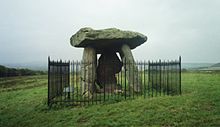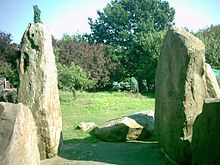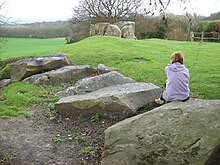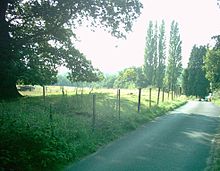Medway Tomb
The Medway Tombs (also called Kent group) are the smallest group of a megalithic type in England . It consists of eight, at least partially preserved, systems in Kent . They are located in the lower valley of the Medway , on both sides of the river in now often eroded, earthen long hills. They have long chambers dating from 2500 to 1700 BC. BC, at the end of the Neolithic. The Medway Tombs and an equally small group in Derbyshire (Derbyshire chamber tombs) and are the only megalithic complexes in the eastern half of England.
On the west side of the Medway are:
- the Coldrum Stones, the Addington Long Barrow, and the Chestnuts Long Barrow.
On the east side of the Medway are:
- Kit's Coty House, Little Kit's Coty House, the White Horse Stones and the Coffin Stone of Kent. There's another one on Dartmoor .
Kit's Coty House
Kit's Coty House is on Blue Bell Hill near Aylesford, on the edge of a field. The four preserved stones are the original access to a destroyed grave in a 70 m long mound (Long Barrow). The stones are quartz sandstones of the same type that were used in Stonehenge . The three bearing stones and the horizontal capstone reach up to a height of almost three meters. Another stone, known as the General Stone, lay at the western end of the hill that was destroyed in 1867. The facility was discovered for archeology in 1854 by Thomas Wright. He found rough pottery under the stones. In 1885 the site was one of the first in Great Britain to be declared an "Ancient Monument" and a few years later it was protected with a metal railing. During excavations in the foreground, the remains of a Neolithic nave were found.
The legend
The complex is traditionally regarded locally as the grave of Catigern , Vortimer's brother and son of Vortigern , who is said to be buried here after a fight against the Saxon Horsa , listed in the Anglo-Saxon Chronicle of 455 AD.
Little Kit's Coty House
Little Kit's Coty House, is 450 m south of Kit's Coty House. They are the remains of another Neolithic Long Barrow, believed to have been destroyed in the 17th century. They are also called Countless Stones or "the countless stones". It is said that you always come up with a different number of stones, no matter how often you count them. There are also stories of the fate of the people who tried. William Stukeley tried to reconstruct the facility in the 18th century. Archaeological digs in 1989 revealed no clear evidence of a quarrying trench that should have existed to provide material to cover the mound. Instead, Iron Age activities were found nearby . Its ground plan shows an irregular octagon half made of five stones, in front of which there is an entrance constructed from four stones, which was provided with a capstone in the middle.
The Coffin Stone
The Coffin Stone (Eng. Sargstein) is located 400 m west of Little Kit's Coty House in the middle of a vineyard. It is a flat, rectangular stone 4.4 m long and 2.8 m wide. There are two smaller stones nearby. In 1836, farmers reportedly found "a sack of bones" under the stone. This is the only written report and it is uncertain what the bones were about. The stone is possibly the remainder of a long barrow. Archaeological excavations in the summer of 2008 did not provide any clear information.
The Coldrum Stones
The Coldrum Stones (also Coldrum Long Barrow) are another remnant of a Medway tomb. The megaliths are west of the river near Trottiscliffe. Despite the damage caused by treasure hunters, it is the Medway Group's best-preserved facility. In addition to the stones of the chamber, the fallen stones of the hill border have been preserved. When the mound was excavated in 1910, the remains of 22 people were found in the chamber, including the skull of one that had been placed elevated. Many of the long bones appeared to be intentionally broken, and some have been diagnosed with rheumatism. It is possible that the name "Coldrum" comes from the old Cornish word "Galdrum" which means "place of enchantment".
Long Barrows at Addington
Chestnuts
Chestnuts is an excavated Long Barrow near Addington south of Trottiscliffe. The burial mound was demolished, but the large stones, some of which were raised again, remained. The four large stones on the facade and four more in the middle of the hill were part of the chamber. An even larger stone lying on the side is likely a former capstone. There may originally have been another stone in the chamber that was split and probably another stone blocked the entrance. In 1957, during excavations, John Alexander found the remains of the burned bones of at least nine people and objects from the late Neolithic or early Bronze Age .
The chamber was about four meters long, two meters wide and three meters high. The angular hill was 20 meters long and maybe 15 meters wide.
Addington Long Barrow
Close to Chestnuts is the Addington Long Barrow. A modern road leads through the heavily damaged Long Barrow. The slightly conical burial mound is 60 m long and 14 to 11 m wide. Remnants of the chamber could be indicated by a number of fallen stones on the east side of the road. In 1845 a local pastor dug in the hill. He is said to have found human bones. In 1981 archaeologists found 25 original curbs on all four sides of the hill.
literature
- Frances Lynch: Megalithic tombs and Long Barrows in Britain . Shire, Princes Risborough 1997, ISBN 0-7478-0341-2 p. 55 ( Shire archeology 73).




